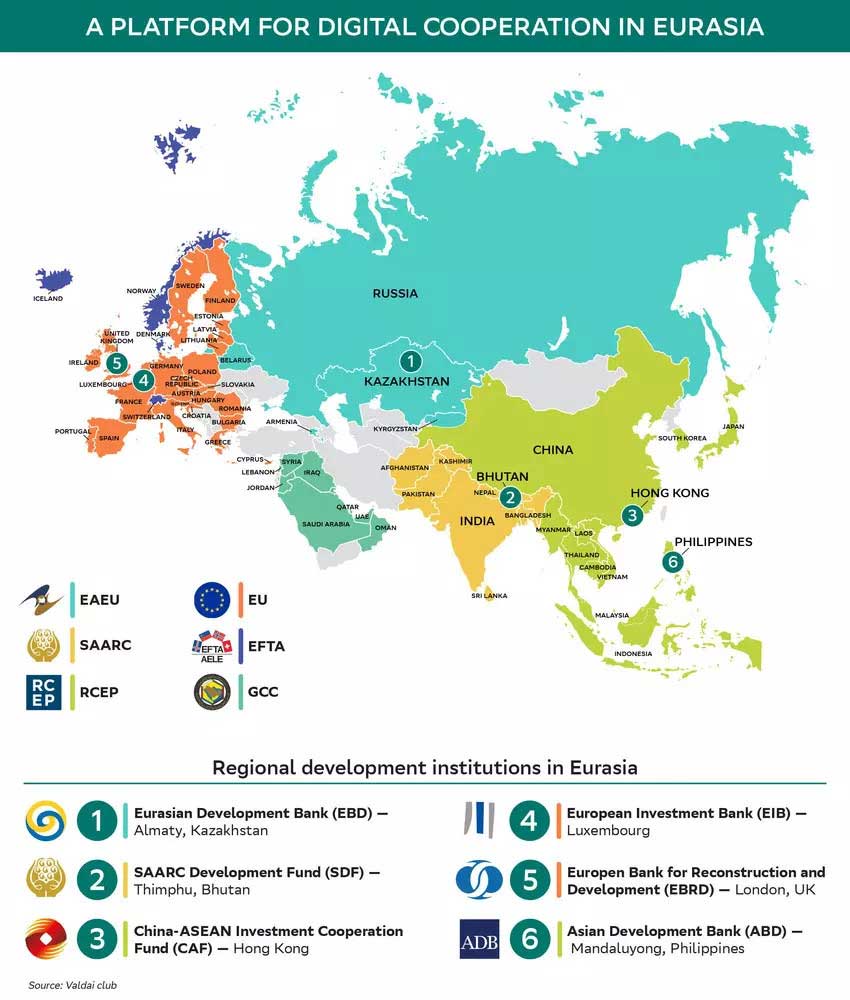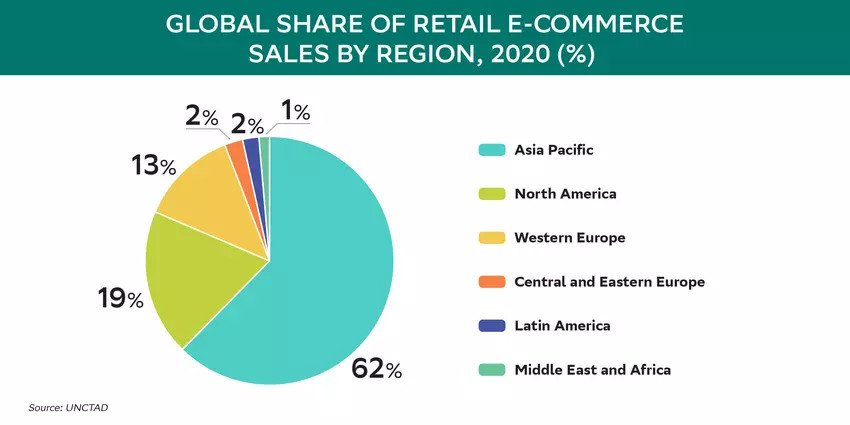The Need For Greater Eurasian Digitization
Eurasia accounts for nearly 80% of global ecommerce sales
Yaroslav Lissovolik, of Sberbanks’ Analytical Division for Global Markets has called for a ‘Digital platform for Eurasia’ that could help unite the entire region.
In a piece for the World Economic Forum, Lissovolik said that “In order to improve its economic dynamism, Eurasia needs to expand the operation of continental “network effects” in line with the emergence of corporate and regional digital platforms and ecosystems” and identified three main points:
- The current challenge is to bring out the best from different parts of Eurasia to create a human-centered digital platform that is globally competitive.
- Such a platform among Eurasia’s regional integration arrangements and development institutions would enable the pooling of resources to combat future economic downturns.
- Of all the parts of the global economy, Eurasia stands to benefit the most from greater digital connectivity and inclusivity, given the prominence of the “distance factor”.
Such a platform becomes particularly important during crises such as the current COVID-19 pandemic that has severely affected trade and migration flows throughout the region. The high concentration of the world’s population in Eurasia implies that the continent is also the largest data-generator in the world, which calls for developing ways of coordinating digital cooperation across countries.
Bridging gaps across the Eurasian expanse
Currently, the main gap in regional and global governance is the lack of coordination among the regional integration arrangements and their development institutions. Indeed, there is no horizontal coordination mechanism for such cooperation. The creation of such a platform among the regional integration arrangements and their development institutions would allow for the pooling of resources to finance large-scale projects as well as to combat future economic downturns. There is also the benefit of creating a more synchronized and coordinated approach to economic policy measures during economic crises.
Another important gap is the lack of digital connectivity in Eurasia that cross-country and cross-regional digital agreements would be predicated on. This, in turn, limits the capability of countries to coordinate policies in areas such as trade, migration and digital economy development.
The common platform would address the issue of the “digital gap” across the countries of Eurasia by promoting greater “digital inclusivity”, most notably with respect to the low-income economies. The common digital platform could prove particularly important for land-locked developing countries that face notable geographical/logistic barriers to trade.
Of all the different parts of the global economy, Eurasia stands to benefit the most from greater digital connectivity and inclusivity, given the prominence of the “distance factor” that constrains the intensity of economic cooperation within the region. The gravity of distance is particularly costly for Eurasia’s land-locked economies – Eurasia contains 26 of the worlds 44 landlocked countries.

A digital platform for regional arrangements and development institutions
To overcome the challenges of distance and fragmentation in Eurasia, there is a need to create a digital platform for Eurasia comprising regional integration arrangements, regional development banks and regional financing arrangements (RFAs).
A Platform for regional integration arrangements would work towards advancing greater inter-operability into the digital platforms of Eurasia’s regional groupings such as the EU, Eurasian Economic Union (EAEU), Association of Southeast Asian Nations (ASEAN), Regional Comprehensive Economic Partnership (RCEP), European Free Trade Association (EFTA) and Gulf Cooperation Council (GCC).
A Platform for regional development banks and funds such as the Eurasian Development Bank (EDB), European Investment Bank (EIB), SAARC Development Fund (SDF) and China-ASEAN Investment Cooperation Fund (CAF) would focus on building project portfolios in digital cooperation/digital connectivity/digital inclusiveness and work to advance digital economic agreements (DEAs) based on the existing digital arrangements.
A Platform for regional financing arrangements, such as the European Stability Mechanism (ESM), Eurasian Fund for Stabilization and Development (EFSD), Chiang Mai Initiative Multilateralization, and Arab Monetary Fund, would focus on the coordination of anti-crisis measures, the creation of ex-ante anti-crisis response mechanisms based on digital cooperation, and data exchange.
These three platforms could reinforce one another and be further complemented by country-level and corporate-level platforms to form a Eurasian ecosystem of digital cooperation and inter-operability.
A crucial element of such a platform could be an aggregation of the network of the DEAs. Singapore is Eurasia’s leader in advancing digital cooperation in the world economy – so far, it is part of all the main digital economy accords: the Comprehensive and Progressive Agreement for Trans-Pacific Partnership (CPTPP), Regional Comprehensive Economic Partnership (RCEP), Singapore-Australia, and Singapore-Chile-New Zealand. Greater openness in Eurasia via digital accords could provide a boost to e-commerce not only in the region, but also globally, as Eurasia accounts for nearly 80% of global ecommerce sales.

Advancing openness and inclusivity across Eurasia
By consolidating regional, bilateral as well as corporate alliances, a common Eurasian digital platform would allow its members to introduce greater consistency and compatibility into the existing set of digital economic agreements, thereby providing the conditions for multilateralising existing digital arrangements and for creating new digital economic accords. An important aspect of the operation of such a platform is the principle of openness and inclusivity – whereby developing countries benefit from greater “digital inclusion” and the possibility to join digital alliances with advanced economies across Eurasia. In this way, the operation of such a platform contributes to a more sustainable and balanced economic paradigm across Eurasia.
A digital platform for regional arrangements could advance not only greater inter-operability, digital commerce, or the conclusion of DEAs, but also harbor sizeable “second round” effects associated with greater scope for connectivity projects (related to physical infrastructure), human capital development (digital platforms in education and healthcare), and innovation.
A significant role could be played by global multilateral institutions such as the IMF, World Bank and WTO. This is because these organizations are already leading the creation of platforms for regional arrangements and their regional institutions. In particular, the IMF together with the G20 has established regular meetings with regional financing arrangements such as the EFSD, Latin American Reserve Fund (FLAR), Chiang Mai, ESM, the BRICS Contingent Reserve Arrangement (CRA) and the Arab Monetary Fund. In 2018, the World Bank created a platform for migration policy coordination among the leading regional development banks.
This article originally appeared on the World Economic Forum website and can be viewed here.
Related Reading
- Digital Integration in Trade, Logistics and Supply Chains with China
- Foreign Manufacturers In Russia May Need To Comply With Digital Source Of Overseas Origin Requirements
About Us
Silk Road Briefing is written by Dezan Shira & Associates. The firm has 28 offices throughout Asia, and assists foreign investors into the region. For strategic advisory and business intelligence issues please contact the firm at silkroad@dezshira.com or visit www.dezshira.com





